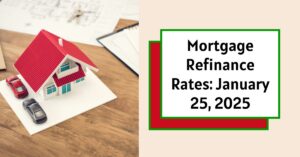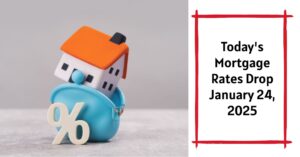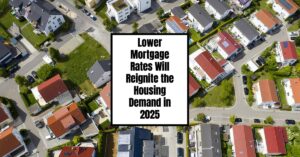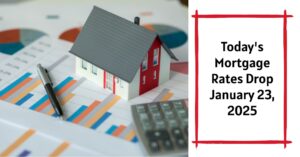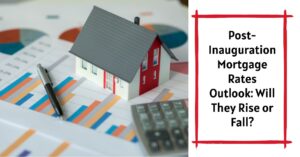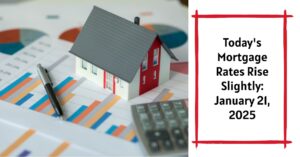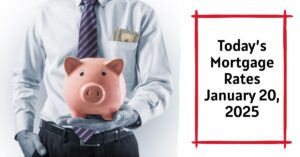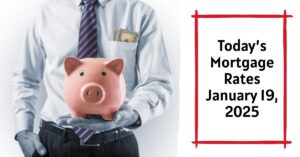Are you feeling the pinch of your current mortgage payments? Wondering if there’s a way to free up some cash or even pay off your home faster? Well, you’re not alone! As of January 25, 2025, mortgage refinance rates are showing some interesting trends that could potentially benefit you.
The market is certainly not what it was a couple of years ago with those rock-bottom rates, but it’s also not as high as it could be. In short, yes, there are opportunities for homeowners to secure competitive terms, but whether it's the “right” time for you is more nuanced. Let's dig into the numbers, see what's moving the market, and figure out if refinancing makes sense for your personal situation.
Mortgage Refinance Rates January 25, 2025: Is Now The Right Time To Refinance?
Today's Refinance Rates at a Glance
Alright, let’s get straight to the good stuff – the actual rates. As of today, January 25, 2025, Zillow’s national averages (rounded to the nearest hundredth) for mortgage refinance rates are as follows:
| Loan Type | Average Rate |
|---|---|
| 30-year fixed | 6.75% |
| 20-year fixed | 6.45% |
| 15-year fixed | 6.08% |
| 5/1 ARM | 6.68% |
| 7/1 ARM | 6.64% |
| 30-year VA | 6.16% |
| 15-year VA | 5.89% |
| 5/1 VA ARM | 6.08% |
Now, here’s something important to keep in mind: refinance rates are often a bit higher than the rates you see for purchasing a home. It’s just the way the system is, though there are always exceptions based on how the market is behaving. So, if you’re comparing rates, be sure you’re looking at the correct ones.
Key Trends Shaping Today's Rates
So, why are these rates what they are? Several factors play a role, and understanding them can help us anticipate where things might be headed.
- Federal Reserve Policy: The Fed is like the central nervous system of the economy. In late 2024, they made three rate cuts, which helped lower borrowing costs across the board. However, they’re proceeding cautiously in 2025. They are predicting only two additional cuts. This is like a seesaw – they want to keep the economy moving, but also keep inflation in check. Inflation was at 2.9% in December 2024, which is still a bit high and means they might hold off on further rate drops for now. I think this cautious approach is understandable and prudent.
- Housing Market Stability: For a while, home prices were going up like crazy. They seem to have finally stabilized, which is good for everyone in the long run. There still aren't many houses for sale, though, which keeps prices supported. For those of us already owning homes, this means you probably have some decent equity built up that you might be able to tap into or use to lower your monthly payments by refinancing.
- VA Loan Advantages: If you’re a veteran or on active duty, you should definitely pay attention to this. VA loans are government-backed and tend to have some seriously attractive rates. The 15-year VA refinance rate, at 5.89%, is particularly eye-catching, it is about 0.2% lower than conventional 15-year loans! In my opinion, if you qualify for this, it’s something you need to investigate immediately.
Refinance Opportunities by Loan Type
Okay, let's break it down even further, looking at the different kinds of mortgages and the refinance options that might be attractive to you:
- Fixed-Rate Mortgages: These are the classic, stable, “what you see is what you get” kind of loans.
- 30-year fixed (6.75%): If your main goal is to have consistent payments that won’t change, this is a pretty safe bet. It gives you that long-term stability.
- 20-year fixed (6.45%): This is kind of the middle ground option. You’ll pay it off faster than a 30-year loan and often get a slightly better interest rate, but still keep the monthly payment relatively reasonable.
- 15-year fixed (6.08%): If you are serious about building equity fast, this is the way to go. For example, if you refinanced a $340,000 loan from a 7.5% rate to a 6.08% rate, that could save you over $50,000 in interest over the life of the loan. It's a powerful tool, but definitely one that you have to be able to budget for, since monthly payments will be higher.
- Adjustable-Rate Mortgages (ARMs): These loans have rates that are fixed for an initial period but then adjust based on market conditions.
- 5/1 ARM (6.68%) and 7/1 ARM (6.64%): These rates are a bit below the average fixed-rate mortgages. These could make sense for you if you plan to move or refinance again before the adjustable period kicks in (which is after 5 years or 7 years in these cases). It’s a gamble but can pay off.
- VA Loans: Here, we are talking about the specific benefits for our veterans and service members.
- 30-year VA (6.16%): This is a strong contender for vets wanting long-term stability.
- 15-year VA (5.89%): As mentioned earlier, this is currently the lowest rate on the market. If you are eligible, it is an absolute no-brainer to check if you can make it work for you. It will accelerate your equity building.
- 5/1 VA ARM (6.08%): This option combines VA benefits with that short-term flexibility of an ARM. If you know you might sell before the rate adjusts, it’s worth looking at.
Should You Refinance in January 2025?
Okay, so now we are getting to the million-dollar question. Is refinancing the right move for you right now? Here are a few reasons why it might make sense:
- You can secure a lower rate: This one is the most obvious one! Even a small drop, like 0.5% to 1%, can add up to significant savings. For example, if you lower a $340,000 loan from a 7.5% rate down to 6.75%, that could save you something like $150 per month. It is a substantial saving over the life of the loan.
- You want to shorten your loan term: If you shift from a 30-year loan to a 15-year loan, you’ll build equity faster, though as I mentioned earlier your monthly payments will go up. Think about it this way, you are making your money work for you.
- You can take advantage of VA rates: If you’re a veteran or on active duty, you can access today's lowest rates, such as 5.89% for a 15-year VA loan. This is an amazing benefit if you qualify!
- You want to tap into your equity: If you've built up enough equity, you could also look at a “cash-out” refinance, which allows you to take out some of your equity in cash. Be careful with this strategy though because you will end up paying interest on the money you withdraw.
Now, I know it might sound like a no-brainer. But here’s a crucial point: you need to calculate your break-even point. This is basically the point where the money you save each month covers the cost you have to pay for the refinance. Divide the closing costs by the monthly savings. If it takes more than two to three years to break even, it might not make sense.
Tips to Secure the Best Refinance Rate
So, you’re thinking about refinancing, but you want the best deal possible, right? Here are a few tips to help you get there:
- Boost your credit score: This one is simple but hugely impactful. If your credit score is above 740, you'll typically qualify for rates that are 0.25%-0.5% lower than if you have a score below 700. That can mean a ton of savings over the long run, so make sure your credit is in good shape.
- Shop around and compare lenders: Don't just go with the first lender that you come across. Even a 0.1% difference in interest rates can save you $10,000 or more over a 30-year loan. That means it is worth doing your homework.
- Consider buying points: Buying points is essentially where you pay upfront fees to lower your interest rate. It’s something to consider if you plan to live in your home for a long time, as it will probably pay off over the long haul. If you are just planning to live in the home for a short period, then do the math to see if it actually makes sense.
Looking Ahead: 2025 Rate Forecast
Nobody has a crystal ball, but analysts are predicting that refinance rates might continue to drop later in 2025. They think that 30-year fixed rates could potentially go down to 6.5% if inflation cools down. But always remember that the world is complicated and there are a lot of factors that can change things. Things like geopolitical events, government policies, could all have a big impact on short-term volatility. So, while this is the forecast, remember that things can change!
Final Thoughts
January 2025 is presenting some really good chances to refinance, especially if you qualify for those lower VA rates or you're wanting to go for a shorter loan term. It’s definitely not the lowest rates we have ever seen, but they are still below historical averages. Don’t just rely on Zillow or any other single source – use those as starting points, but be sure to shop around as each lender will give different offers.
My personal advice is to use a mortgage calculator to play around with different scenarios based on these rates. Keep an eye on announcements from the Federal Reserve as well as housing market news as these will impact rates over the next few months. If you have the opportunity and it makes sense for your budget, it could be a very worthwhile financial move!
Work with Norada, Your Trusted Source for
Turnkey Rental Properties
Discover high-quality, ready-to-rent properties designed to deliver consistent returns.
Contact us today to expand your real estate portfolio with confidence.
Contact our investment counselors (No Obligation):
(800) 611-3060
Recommended Read:
- Best Time to Refinance Your Mortgage: Expert Insights
- Should I Refinance My Mortgage Now or Wait Until 2025?
- When You Refinance a Mortgage Do the 30 Years Start Over?
- Should You Refinance as Mortgage Rates Reach Lowest Level in Over a Year?
- NAR Predicts 6% Mortgage Rates in 2025 Will Boost Housing Market
- Mortgage Rates Predictions for 2025: Expert Forecast
- Half of Recent Home Buyers Got Mortgage Rates Below 5%
- Mortgage Rates Need to Drop by 2% Before Buying Spree Begins
- Will Mortgage Rates Ever Be 3% Again: Future Outlook
- Mortgage Rates Predictions for Next 2 Years
- Mortgage Rate Predictions for Next 5 Years
